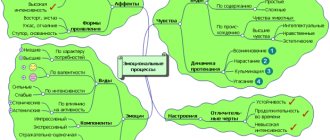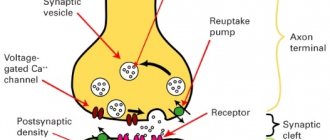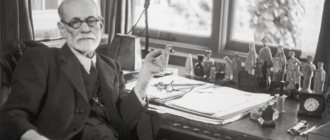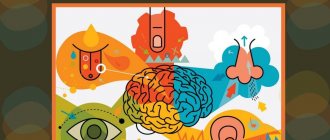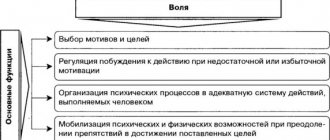The cerebral cortex is involved in complex imagination processes. But the complexity of the structure of imagination and its connection with emotions testify in favor of the hypothesis that the physiological mechanisms of imagination are located not only in the cerebral cortex, but also in deeper parts of the brain. Such deep parts of the brain, which, together with the cerebral cortex, form images of the imagination and include them in activity processes, are the hypothalamic-limbic
system, the hypothalamus in its connections with the ancient cortex and subcortical areas forming the limbus, or boundary, around the anterior part of the brainstem at the entrance to the cerebral hemispheres
When the hypothalamic-limbic system is damaged, a person develops characteristic mental disorders: his behavior consists of a series of individual behavioral acts, and the general program regulating behavior varies from day to day. So, the damage has captured the structures responsible for planning human actions, and, as you know, the most important function of the imagination is the development of a program of action, behavior.
Some scientists consider the physiological mechanism of imagination as the movement of ideas that replace each other like sea waves. These representations are created by certain associative connections. “The intensity of another trace, having reached a certain degree, then begins to decrease, while the intensity of the second trace (association) begins to increase, and as a result of this, one representation changes into another” (KD. Ushinsky. D. Ushinsky).
The duration of the idea (that is, the duration of its awareness) depends on the time that is necessary for it to come into balance. During this time, the movement of the idea, which was in a state of tension, spreads to another idea (especially bright, vital), and then this latter goes into a state of tension.
The level of intensity of the nerve trace depends not only on its process, but also on the degree of irritation to which this trace is subject. If in the processes of memory the nervous connection formed is permanently lost and restored in the future, then in the processes of imagination the systems of nervous connections disintegrate and are not restored, but are united into new systems throughout a person’s life.
Such a union is possible when a strong excitation cell arises (need, direct impression). Therefore, in a person with great imagination, groups of nerve cells are connected into more and more new formations. The characteristic novelty in the images of fantasy in comparison with the images of memory and their partial failure depend on this.
93 types of imagination Processes of imagination
The process of creating images of the imagination, or fantasies, can have involuntary and voluntary
character
When in the human imagination the creation of new images is not directed by a special goal, the imagination has a spontaneous
character. Thus, under the influence of the teacher’s story, new images are created, their separation or combination occurs. When reading a work of art, images of the heroes of your story, the area where the events take place, the time when they occur, etc., appear in the imagination without any special intention.
Involuntary imagination is determined by needs and feelings. A hungry person imagines delicious dishes, a person freezing in the cold imagines a warm house, and in the heat, imagination brings coolness to a person. Parents, worried about their children who are taking exams, involuntarily picture the course of events and imagine critical situations that their son or daughter may find themselves in.
When a person sets a special goal to create an image of a particular object, the imagination acquires an arbitrary
character. For example, a teacher in a lesson suggests imagining some historical event, a certain area, traveling on a map, imagining certain cities or countries
A person creates a new piece of music, draws an image of a literary character or a picture, uses his free imagination
Depending on the nature of human activity, voluntary imagination is divided into reproductive, or reproductive, and creative
Imagination, based on the creation of images that correspond to the description, is called reproduced
. By reading educational and fiction literature, studying geographical maps and historical materials, a person reproduces with the help of his imagination what is reflected in works of art and historical documents. During linguistic communication, when a person has to imagine unfamiliar objects or events based on their description, the reproductive, or reproducing, imagination is triggered. Reproductive imagination serves communication between people and. This type of imagination is used by an engineer who studies a new machine from the drawings. On the basis of musical works, rich material for reproductive performances is formed.
. Creative
imagination is also voluntary, productive in nature and is always included in creative activity. This is the independent creation of new, original images. Creativity is an activity as a result of which a person discovers something new, creates new original works, material and spiritual values. Creativity is a type of activity in which all mental processes are involved, but imagination plays a leading role. Creative imagination is necessary where human activity acquires a creative character; it is an essential condition for any type of creativity. Creative and reproductive imagination are interconnected and go one into the other.
The view is divided into active
and passive
. Active
imagination is always aimed at performing a creative or logical task. The process of storing information in the brain is dynamic, that is, there is a gradual change in the content of the material and the mutual movement of its elements. This process reflects an active imagination. Hence - intuition, insight. Active imagination is directed primarily outward; a person is more occupied with the environment, socially significant things, and less with himself. The active element is determined and controlled by the will; it can be reproduced (reproductive) or creative. The apparatus of imagination constitutes the condition for the creative activity of personality.
. Passive
imagination flows without setting a goal, sometimes like an illusion of life, where a person speaks and acts mentally. She temporarily retreats into the world of fantastic ideas that are far from reality. It seems to a person that she is exhausted from unsolved problems, from the need to act, from difficult living conditions.
A person can intentionally evoke passive imagination. Evoked images of fantasy that are not associated with the will and are aimed at bringing them to life are called delirium. People are prone to delirium. It is easy to find in them a connection between the products of the imagination and human needs. When a person’s needs are extremely strong, and the possibilities of satisfying them are scanty, then the imagination develops with amazing force. A satisfied need does not generate imagination. Since it is impossible to fulfill most needs, a person develops a dominant dissatisfaction, which gives rise to a change in personality with a departure from reality, suffering, stubbornness, and neurosis.
Satisfaction of human needs is not always accompanied by a feeling of satisfaction. Quite often, the expectation of great happiness minimizes the feeling of real pleasure from real happiness. Consequently, there is a tension between expectations and what has been achieved in life, which is why it is so difficult to control the imagination.
If delirium, that is, images that are evoked arbitrarily and are not aimed at being translated into reality, predominate in the imagination, then this indicates the passivity of a person, his inaction, and possibly the defectiveness of a scroll of personalities.
For the emergence of passive imagination, the emotional state is of great importance. Passive involuntary imagination occurs in a state of passion, during sleep. Sleep is a passive state of a person. Before falling asleep, a person dreams about something, and the imagination is liberated and strengthened. This process is very important for the occurrence of sleep. It is quite difficult to fall asleep when a person is excited. The best way to maintain your sleep is to switch your imagination to pleasant, calm themes. An example of the spontaneous emergence of new images is dreams during sleep, when our attention is not distracted by external impressions, the aimless and traceless wanderings of consciousness “with the peaks of miles of movements of the nervous system” acquires the vivid character of dreams, of which we remember only some, i.e. we transform it into new associations - the formation of our imagination. In a dream, we get a full impression of the situation; in reality, we imagine it. The brightness of the imagination during sleep is explained by the fact that the second signaling system is inhibited and the first signaling system is excited, the law of negative induction is triggered.
Dreaming is a biologically beneficial process, one of those that maintains the functional efficiency of the nervous system. However, the content of dreams is only a random result that cannot be reliably interpreted. THEM. Sechenov called dreams “unprecedented combinations of past impressions of the enemy.”
From the point of view of the theory of psychoanalysis of Z. Freud, the cause of dreams lies primarily in the irresistible instinctive activity of the unconscious system of the human mental apparatus. By. Freud, the occurrence of a sleepy state psychologically indicates that a person has become detached from the outside world and has focused on his own “I” Such a phenomenon. Freud called “primary narcissism.” In this regard, all instinctive stimuli coming from various organs of the body are significantly intensified (cathexed). human impulses and desires appear to be perfect, even fantastic situations are perceived by the sleeping person as quite real. This phenomenon is called “hallucinatory wish fulfillment” called “hallucinatory vikonannya bazan”.
the concentrated direction of dreams is the reason for the emergence of a special feeling that events are taking place in their own, completely closed world. Man has no power either to react or to evaluate his alienations. That is why the most incredible events that occur in dreams are perceived by a sleeping person without any surprise; they do not cause her indignation or protest.
Strengthening, as well as weakening, imagination can be a symptom of serious mental illness. People who did not sleep for 70 hours during the experiment developed mental and neurotic disorders. Neuroses and psychosis often occur in young mothers, when all their strength is focused on the child, there are no switches or other information, and there is a constant lack of sleep. Therefore, it is so important to create an atmosphere around the young mother for an era of fulfilling, interesting, calm life, so that restful sleep and good mood are maintained. Another example: prolonged consumption of alcohol leads to an “explosion” of paradoxical sleep, which leads to vivid, terrifying dreams (dreams), fear, hallucinations and lucinations.
Imagination manifests itself in activities of different content, therefore the following types of imagination are distinguished: artistic, scientific, technical
etc. All these types of imagination have their own characteristics
In artistic
the imagination is dominated by sensory (visual, auditory, etc.) images, extremely detailed and vivid. The human artist imagines the images of the heroes so vividly, as if these heroes actually communicate with her, live next to her
Different types of artistic imagination have their own specific characteristics. These features are manifested in the creation of images of artistic imagination, when one or another analyzer predominates: visual and motor - for a sculptor, an artist, auditory - for a composer, etc. The means with which a human artist operates and the ways of embodying images are distinctive. paintings, scores, poetic lines).
. Technical
the imagination creates images of spatial relationships in the form of geometric figures with the mental design of them in various combinations. Associations by similarity play an important role in the creation of new technical designs. Images of the technical imagination are materialized in drawings and diagrams, with the help of which new items and objects are created. Products of the technical imagination can be represented in linguistic form. Language fixation helps to deeply analyze technical discoveries and verify their reliability in practice.
. Scientific
imagination is embodied in planning and conducting experimental research, in the ability to build hypotheses, finding extraordinary ways to solve a problem, in constructing an experimental situation, the ability to generalize empirical material, etc. New images of scientific imagination are created, which is a means by which natural relationships between objects and phenomena. Scientific imagination helps to find new links in the system of facts that are not yet known.
Scientific imagination is always based on precise scientific calculations and experiments. Something imaginary that has not withstood scientific and practical testing is rejected. Scientific imagination is embodied in words, as well as in images.
A special type of imagination is a dream
. A dream is an imagination aimed at the future, at the prospects of human life and activity. In dreams, images of what is desired are created. The importance of dreams in a person’s life is extremely great. Dreams reveal the connection between a person’s imagination and his needs, feelings, and aspirations. Dreams become the impetus for creative activity, as the lives of many outstanding people convince us of.
Social existence and social relations determine people’s dreams, which determine the direction and nature of dreams, but a lot depends on how the person himself relates to his dreams and how he sees the realization of his own in certain social relations. MRI.
There is also the so-called antispasmodic
imagination (from Latin anticipatio - guessing in advance, foresight). It underlies the human ability to foresee future events. The anticipatory imagination extracts building material from the reserves of memory. Anticipation of the future is possible thanks to the hidden reaction of expectation that arises on the basis of imagination. So, a person does not need to jump from the ninth floor to find out how dangerous a fall is. Images of the anticipatory imagination tune the body to certain actions when there is no reason for such moves.
Imagination processes
Imagination processes are analytical-synthetic in nature
and in this they are similar to the processes of perception, memory, thinking
If memory restores images and situations, copying real ones, then imagination creates new images and situations that have not arisen before; the mechanism of imagination is based on the images that a person has, but these images appear in new unexpected connections and combinations. The word “new” has a double meaning: distinguished objectively
new and
subjectively
new. Objectively new are images, ideas that do not exist at this moment, either materially or ideally. Subjectively new is new for each specific person (child). The new image of the imagination can be materialized or remain at the ideal level.
Imagination processes are analytical and synthetic in nature and are carried out in various ways. The main ones:
. Agglutination
(from Latin aggiutinare - to glue) - creating a new image by combining elements taken from different ideas. For example, the image of a mermaid in fairy tales, where the head and body are women, and the tail is a fish. This technique has not become widespread, since its images are difficult to translate into objective things. However, we have examples of the materialization of such images in real life - a tank, an accordion, an amphibian, a trolley bus.
. Hyperbolization
- characterized by an increase in the object (the giant Gulliver) by a change in the number of parts of the object (a dragon that has seven heads), or by their displacement
litotes
- in contrast to hyperbolization, it is characterized by a decrease in the subject (thumb). These techniques are used in folk tales and fantastic works.
. Underline
- emphasizing some part of the image or a certain quality. Using this technique, cartoons and caricatures are created.
. Schematization
- an image of the imagination when differences are reduced and similarities come to the fore. An example is an ornament, the elements of which are taken by the artist from the plant world
. Typing -
highlighting the essential in homogeneous facts and embodying them in specific images. This is a complex technique, it is widely used in literature
The creative process of imagination is based on the emergence of associations, although their specificity differs from the usual course of associations, being subject to thoughts, emotions, desires, in the psyche of the human artist. The mechanism of associations is the same (association by similarity, by contiguity, by contrast), and the selection of ideas is determined precisely by these preferential tendencies.
